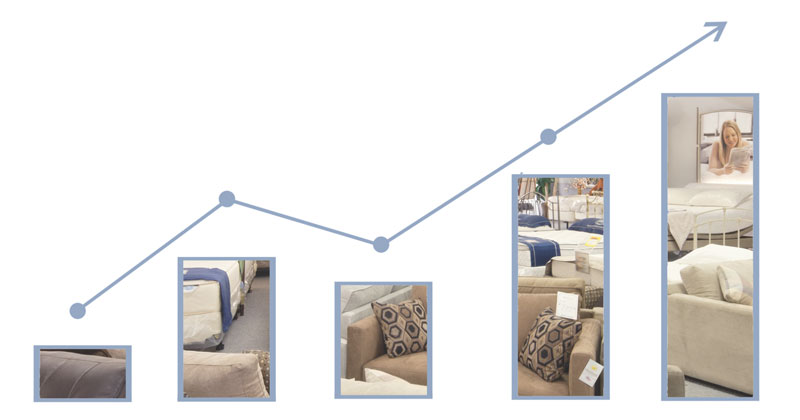Commentary from Bill Napier adn Ed Tashjian
Bill Napier and Ed Tashjian debate whether or not the furniture industry is
headed for disaster. Bill sees the glass half empty, Ed is worried that it’s
not big enough.
Editor’s Note: Bill Napier and Ed Tashjian are at it
again. Bill, nicknamed Darth Napier by his friend and co-debater Ed
Tashjian, share their views about the future of home furnishings
retail.
Bill’s Point: Unhappy Times are Here Again
Why is our industry hurting? The answer is simple: we don’t do our due
diligence, we ignore the facts, and then we’re left to react, usually with
excuses. I call this THE ARROGANCE OF IGNORANCE.
A recent Smith Leonard Furniture Insights® report noted that “Year to date,
new [furniture manufacturing] orders were down 8% compared to the same [YTD]
period in 2022.” This figure, they point out, doesn’t tell the whole story:
June 2023 orders were well up over June 2022, which in turn was
significantly down from June 2021. It’s complicated and the situation, they
say, for the remainder of 2023 remains “murky.”
Much can be said regarding the furniture business’s current sluggish state,
including inventory problems, but this is getting to be a really old excuse.
The main culprit—It’s the economy, stupid! We continue to see headwinds due
to persistent problems with the housing market, consumer debt and resulting
furniture-buying trends.
Headwinds
A record number of adults have moved back home to live with their parents. I
doubt this group can afford furniture or most retail expenditures other than
necessities.
According to a December 2022
PropertyManagement.com
survey of 1,200 26 to 41-year-olds, nine million millennials moved back in
with their parents in 2022 due to financial hardships. Their stated reasons
included:
- Saving money—50.9%
- Couldn’t afford rent—39.3%
- Take care of parents—31.5%
- Like living with parents—29.6%
- Personal health issues—22.9%
- Lost my job—21.4%
- Afraid of losing my job—7.1%
You might think that this is due to the after-effects of the pandemic and
that high employment rates will turn this situation around. The truth is
that this is a long-term problem driven in part by a disturbing trend in
home ownership, a direct driver of retail furniture sales.
“And it gets worse. Total household debt increased by 8.5% in 2022 and now
stands at a record $16.9 trillion. That’s $2.75 trillion higher than it was
pre-pandemic.”
Our Home Ownership Problem
Ridiculously high mortgage interest rates have made people reluctant to buy
homes because they are getting much less and paying more. At the same time,
sellers are holding on to their current homes and legacy fixed mortgages.
This is true in virtually every city and town in the U.S. and Canada.
So, what are buyers doing? The rational thing. They are renting and waiting.
Do you know that new apartment construction will reach a historic peak, with
over 460,000 new units expected to come online nationwide? According to
RentCafe, apartment construction last surpassed the 400,000-unit mark in
1972, exceeded that mark in 2021 and is likely to do so again. That’s a
50-year high.
The fact is that people can’t afford homes due to the economy, inflation,
and interest rates. They are delaying that purchase, opting to rent. The
average new apartment is about 1,200 square feet. That means less growth in
the number of rooms, especially larger bedrooms. People aren’t buying whole
rooms of furniture anymore. Instead, they are buying pieces, and usually
small pieces at that.

Bill laments that an average new
apartment is only 1,200 square feet with fewer rooms and small bedrooms
to furnish.
Ed observes that people are
getting married later, creating more single households, and rejoices
that everyone needs a minimum of a bed, a sofa, and a place to eat.
Disposable Income
The most troubling information in recent reports on GDP is the precipitous
drop in real disposable income, which fell over $1 trillion in 2022. For
context, this is the second-largest percentage drop behind only 1932, the
worst year of the Great Depression. The economy is expected to only grow
1.4% in 2023, which stinks!
Student Loan Debt
Forty-five million Americans have student loan debt—about one in seven
Americans (13.5%)—according to an analysis of January 2022 census data.
People 25 to 34 years old are the most likely to hold at least some student
debt, but the greatest dollar amounts are owed by those 35 to 49—more than
$600 billion, federal data shows.
The average amount is $32,731. Monthly payments range from $333 to $1,537,
depending on the degree obtained and borrowed. AND remember, most of these
loans accrue interest, ranging from 5.5% to 8.05% depending on the type of
loan.
These people make up the demographic sweet spot for retail furniture sales.
According to U.S. Federal Reserve data, student debt rose more or less
steadily (not adjusted for inflation) from $.52 trillion in the final
quarter of 2006 to over $1.78 trillion in the first quarter of 2023.
Other student loan facts:
-
The outstanding federal loan balance, including federal and private
loans, is $1.77 trillion, accounting for 93.1% of all student loan debt.
-
43.8 million borrowers have federal student loan debt.
-
The average federal student loan debt balance is $37,338, while the
total average balance (including private loan debt) may be as high as
$40,114.
Given the recent Supreme Court ruling that struck down the Biden
administration’s attempt to forgive large amounts of student debt, this
situation is unlikely to change soon.
“First-time home buyers will havean even more challenging time getting
mortgages. Small and mid-sized retailers will also see an uncomfortable
tightening of their credit lines.”
Another Concern
Something else that might keep you up at night is the evolving situation for
small and regional banks.
Small commercial banks accounted for 57.3% of the $2.752 trillion in
mortgage loans and 45.2% of the $2.071 trillion in consumer loans in 2022,
according to data from S&P Global Market Intelligence. “There’s likely to be
less credit expansion due to this. Banks are going to be a bit stingier.
They’ll want to see their loans-to-deposit ratio decline and have more cash
on hand,” said Chris Varvares, co-head of U.S. Economics at S&P Global
Market Intelligence.
The result will be that first-time home buyers will have an even more
challenging time getting mortgages. Small and mid-sized retailers will also
see an uncomfortable tightening of their credit lines.

Ed says don’t worry. In the long
run, growth in furniture sales is predictable, linear, and dependent on
necessity, function and fashion.
Bill warns that tough times are
already here and are going to get worse due to structural economic
realities.
The Debt Breakdown
And it gets worse. Total household debt increased by 8.5% in 2022 and now
stands at a record $16.9 trillion. That’s $2.75 trillion higher than it was
pre-pandemic. Taken together, the drop in real disposable income plus a
mountain of consumer debt and credit tightening will create a drag on
spending for home buying and home furnishings purchases going forward.
Focus on GMROI
So, how do we navigate these hard truths?
We can’t employ the “usual” tactics. We must find a way to cut costs and use
more technology to streamline operations. I advise thinking and acting GMROI
in every facet of your business! There’s no need for me to go into a
detailed discussion of best practices for tracking and improving GMROI.
Check out recent Furniture World articles by David McMahon visiting
https://www.furninfo.com/authors/david-mcmahon/6
on the following topics:
- Time to Refocus on GMROI
- Traffic & Ways To Get More
- 13 Ways to Make the Most of Your Retail Traffic
- Retail Guest Productivity Metrics
- Retail Metrics: Cash Crunch 2023?
- Recession Planning
Counterpoint: Ed Tashjian
Clearly, our worldviews are not the same. As usual, we might as well be
living on different planets. While Bill sees the half-empty glass, I’m
worried it is not big enough. I base this on economic facts and plain old
common sense.
Economics
Consumer savings are almost as high as they’ve ever been. After spending
like drunken sailors on shore leave, consumers still have more money in
their savings accounts than before COVID-19. They hold approximately $900
billion in excess savings, equivalent to 5% of consumer spending. This would
suggest the scope for consumption to remain resilient for quite a while.
Some excess has flowed into equity securities that are less likely to be
converted into immediate spending but bode well for the future.
If we have a recession, which I think is doubtful, everyone predicts a soft
landing. As our erstwhile President Reagan opined, “The difference between a
recession and a depression is simple. In a recession, your neighbor is out
of work. In a depression, you are.” Unemployment is near the lowest rate in
our lifetime. Anyone who wants a job can likely obtain one. More people are
working than ever before in American history and contributing to the
economy.
Other economic indicators are in our favor. Declining U.S. consumer
inflation, slowing wholesale price increases, and falling import prices sent
the stock market soaring. Most 401(k) plans have nearly recovered (as of
September 1, 2023) from mid-2022 lows. Consumer confidence is rebounding.
According to the University of Michigan, consumer sentiment for the U.S.
increased to 71.6 in July of 2023, the highest level since September of
2021, and well above forecasts of 65.5, preliminary estimates showed. Both
current economic conditions (77.5 vs. 69) and consumer expectations (69.4
vs. 61.5) improved, attributable primarily to the continued slowdown in
inflation and labor market stability.
Spending on infrastructure is likely to spike the economy. Unlike spending
on wars, which goes to defense contractors, this kind of government spending
creates domestic jobs and puts money in people’s pockets.
Student Debt
I do share Bill’s malaise about college debt. More than 45 million people
collectively owe $1.6 trillion, according to U.S. government data. The
typical undergraduate student with loans now finishes school with nearly
$25,000 in debt. It may be the biggest scam in our lifetime. Nothing is more
bloated or overrated than our private education system. It makes me sick to
my stomach when I think about the money that could have been spent on
something more tangible, like furniture. Over time, this will sort itself
out, but that is another topic. What is relevant here is that despite that
debt, most of these people do not have problems getting credit to buy goods
and services – especially furniture.

Bill frets that first-time home
buyers will continue to face challenges getting mortgages. Consumer
debt, especially student debt, is and will be a huge drag on home
furnishings purchases.
Ed agrees but observes that
despite that debt, most of these people don’t and won’t have problems
getting credit to buy goods and services – especially furniture.
Demographics
Demographics are on our side. The number of households is increasing, albeit
at a slower rate, both due to migration and organic increases. Moreover,
people are getting married later, creating more single households. I have
never been in a household without a minimum of a bed, a sofa, and a place to
eat. Have you? Do you think this will ever change? Moreover, and this is
another topic for debate, I believe it is likely that our immigration policy
will change out of necessity in the near future, which will result in a
substantial number of new households.
Other Factors
Regarding the much-maligned cohort of millennials, it may be true that nine
million millennials have moved in with their parents, but 27 million, or
75%, didn’t. We are creating more multi-millionaires in this country than at
any time in its history. In the U.S., there are a little over 22 million
millionaires. Surprisingly, almost a quarter of these are millennials. Not
to belabor a metaphor, but is the millennial glass ¼ empty or ¾ full, with a
heaping portion of cream rising to the top?
At the store level, we are working our way through the retail inventory
glut. Bill may be tired of hearing that as an excuse, but it is legitimate.
The design trade did quite well in the first half of 2023. To be sure, the
retail furniture business is not easy. Its cemeteries are littered with
gravestones of outsiders coming in, believing that easy profits were
available with more sophisticated approaches.
Further, the last three years have been the most unusual and unpredictable
in our careers. We were whipsawed by supply chain fluctuations. COVID
stimulated demand and atypical cost increases. But I cannot think of a more
predictable industry than furniture. Its distribution channels may be
evolving, but over the long run, its growth is linear. It is not likely to
be affected by artificial intelligence or some new technology.
Common Sense
Look around your community. Do you see an increase in the construction of
massive apartment buildings? Have you considered that every new apartment
will need a bed, a sofa and a dining table at a minimum? Bill laments that
an average new apartment is only 1,200 square feet. Where he sees a problem,
I see an opportunity. Manufacturers and retailers alike should be offering
smaller-scale furniture and designing it to fit into elevators.
Regarding GMROI, I mostly agree. No matter how sophisticated your analytics
are, the key to success is to do more of the profitable things and stop
doing or trying to fix the things that aren’t. It isn’t rocket science. One
of the issues in furniture is that stores are too big. Rent, interest and
inventory carrying costs are killers. The stores of the future will likely
be smaller and depend more on technology.
“Bill urges furniture retailers to think about GMROI in every part of their
business. Ed advises retailers not to try to be everything to everybody,
then target customers with visually and verbally sophisticated stories.”
Takeaways
As I near the end of my career and reflect on 40+ years of experience in
this industry, this is my advice to manufacturers and retailers alike. I
apologize in advance that it is not more profound.
Segment your market. There are many paths to success, but the shortest route
to failure is trying to be everything to everyone. It is easier to sell your
customers more than to sell more customers. Try to remember that their
primary goal isn’t to buy furniture. It’s to buy a lifestyle. They shop the
hope of living a more comfortable and satisfying life. That is what
retailers should really be selling, and it manifests in the form of
furnishings.
There are many ways to segment. Pick a niche and be the absolute best at it.
Get to know your ideal customer from their point of view – not yours. I
recommend spending at least a day a month riding in the delivery truck. Get
out of the store and the factory and into the homes of those who purchase
your products. Over my career, I have invested millions of dollars in
marketing research. But nothing has been more helpful than going into
people’s homes.
All great marketing begins with differentiation and the ability to tell your
story. If you can’t tell your stories, then differentiation doesn’t matter.
Part of this is messaging, and part of it is media. It’s not enough to have
great products. Your marketing must speak a verbally and visually
sophisticated language that connects with consumers emotionally and
communicates why your products are different and better. And, you have to
reach them where they consume media. For every target, it’s different.
Furniture demand is based on necessity, function, and fashion. Fortunately
for our industry, people get tired of their furniture. The inexorable desire
for humans to express themselves manifests in their furnishings. We need to
be fashion-forward. Status is every bit as important as function. Furniture
is an expression of self and identity as much as clothing or automobiles. It
is a great business.